Menu
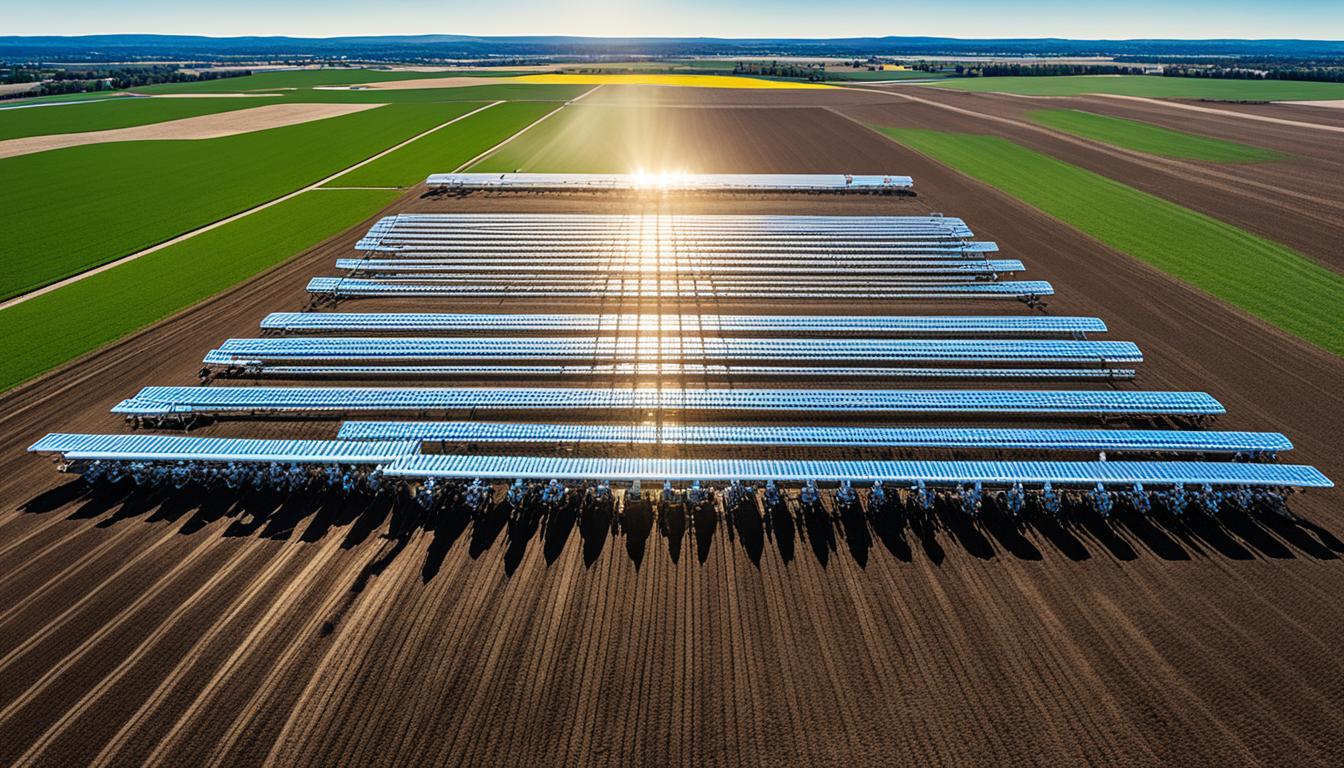
Autonomous farming can slash herbicides and pesticides by up to 95%. This change is a big step towards sustainable farming. It also means better crop yields.
Farming is changing thanks to autonomous equipment. It’s in line with the UN’s aims for responsible farming and to end hunger. These robots handle planting, watering, and pest control on their own. Farmers save time and money, as these tasks are done with precision without a need for human hands.
These equipment use water carefully, thanks to precision farming methods. This makes farming more responsible and helps crops grow better. At the AI for Good Global Summit in Geneva, more than 30 advanced robots were on show. They represent the progress being made in farming technology.
The FAO warns that we’ll need 60% more crops by 2050. The market for farming robots is growing fast, from $43 billion in 2021 to a predicted $81 billion by 2028. This growth is good news, as it shows how important these new technologies are for the future of food.
Autonomous farming robots are changing the game in agriculture. They use high-tech tools to do jobs that needed lots of people. And with this, they cut back on the need for manual work. This makes farming more effective. The growth in the autonomous farm equipment market shows how big this change is.
Autonomous farming robots started long ago with simple machines. They were used to watch over crops and spray fields. Now, these robots are super smart. They use automation and learn from their work to make farming better. This is really important as more food will be needed with more people in the world.
In recent years, many new robots for farming have been made. For example, Root AI’s robots save water but produce way more food. And the Vision RTK Fusion tech helps monitor the health of crops.
| Innovation | Description | Impact |
|---|---|---|
| Agras T40 drone | Can carry 40–50 kg and features a 360-degree horizontal obstacle sensing system | Enhances precision in planting and spraying |
| Solix Sprayer Robot by Solinftec | Services up to 100 acres per day | Increases efficiency in large-scale farming |
| SCARABAEUS mowing and mulching robot by Probotics | Mows within a few centimetres of trees and uses solar power | Promotes sustainable farming practices |
| GEA’s DairyRobot R9500 | Energy-efficient milking robot that detects mastitis in dairy cows | Improves animal health and milk production |
The agricultural robot market is set to grow because of these new inventions. It will help with issues like not enough workers, taking care of the planet, and making sure we have enough food. These changes are improving farming in big ways. They’re not only making more food but also making life better for farmers. As we bring in more of these innovations, farming will keep getting better, bringing more growth to the autonomous farm equipment market.
Robotic agriculture improves farming by making it both smart and efficient. It lowers costs and brings better results. By using agricultural robots, the farming world is changing for the better. Fields can now be farmed more effectively, leading to more produce being grown.
Agricultural robots are much better at their jobs than the old manual ways. They work without stopping and do things very accurately. This means farm work gets done quicker with less waiting time. For example, the RoboWeeder2 can plant 0.4 acres of seeds in an hour, much faster than a person could. These machines can also apply exact amounts of pesticides. This helps reduce waste and looks after our environment better, following a plan to use less chemicals in farming by 2023.
On a one-acre farm, agribots can seed crops three times faster than ten workers could. This speeds up farming, using fewer people. This helps farmers do more work in less time.
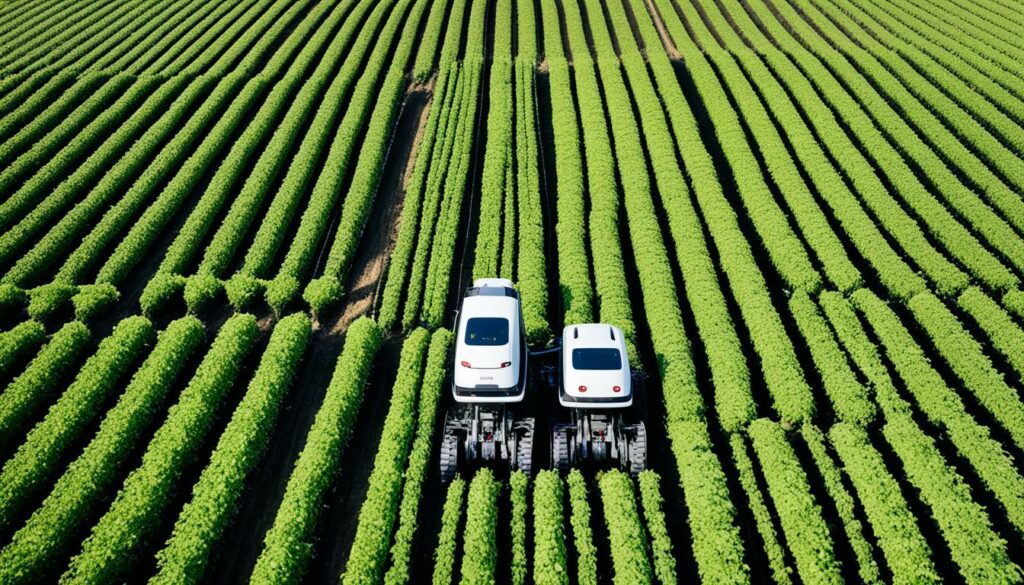
Robotic farming saves a lot of money on human work. About half of the costs of growing crops come from paying people. By using machines, this cost drops. This can make up for not having enough workers to do the job. It also means farmers don’t have to only grow crops that need a lot of people to look after.
Imagine, instead of ten people, you only need two to do the work because of machines. This change lets farmers focus on managing the robots. They can oversee the work and improve how they farm.
The good news is, this also helps the economy. The market for agricultural robots is growing fast, from $43 billion in 2021 to over $81 billion by 2028. These robots mean fewer losses on the farm and more crops. This is important with the world needing 60% more food by 2050.
“Agribots are three times faster than traditional labour, drastically reducing costs and enhancing efficiency.”
Robotic agriculture brings clear benefits. It saves money now and promises a better future. The world of agriculture is changing. Robots are not just helpful, they are becoming crucial for farming that is smart and sustainable.
Autonomous technologies in farming bring a new wave of better productivity, accuracy, and lasting growth. Several key innovations lead the way, changing how farms work today.
At the core of autonomous farming, precision techniques improve how resources are managed. This means machines like tractors can plough and spray fields with incredible accuracy because of GPS and machine learning. ASI makes farming robot vehicles that lead the charge, making every input count and helping farming be sustainable.
Agricultural drones have changed how we look after crops. We’ve seen a big rise in using drones for tasks like checking on crops, watering, and applying pesticides directly. Places like Utah State University are using drones to find soil issues and unwelcome plants. This helps make spraying more accurate and decisions smarter, making farming more efficient and eco-friendly.
Farming robots that use AI and machine learning are making a big difference. They learn from a huge amount of data and become better at what they do over time. In the future, we might have drones guiding a whole troop of ground vehicles, all working to spread chemicals and water just right. This mix of clever thinking and smart robots promises a farming that is more efficient and quick to adapt.
In short, bringing together precision farming techniques, drones, and AI-powered robots shows just how much tech can change farming. These changes will play a big role in keeping our food supply safe and the way we farm environmentally friendly, even in the face of challenges like fewer workers and limited resources.
Driverless farm machinery is changing the face of farming. It’s boosting agricultural efficiency with the help of AI. The autonomous farming equipment market is growing fast, expected to hit $95 billion by 2027.
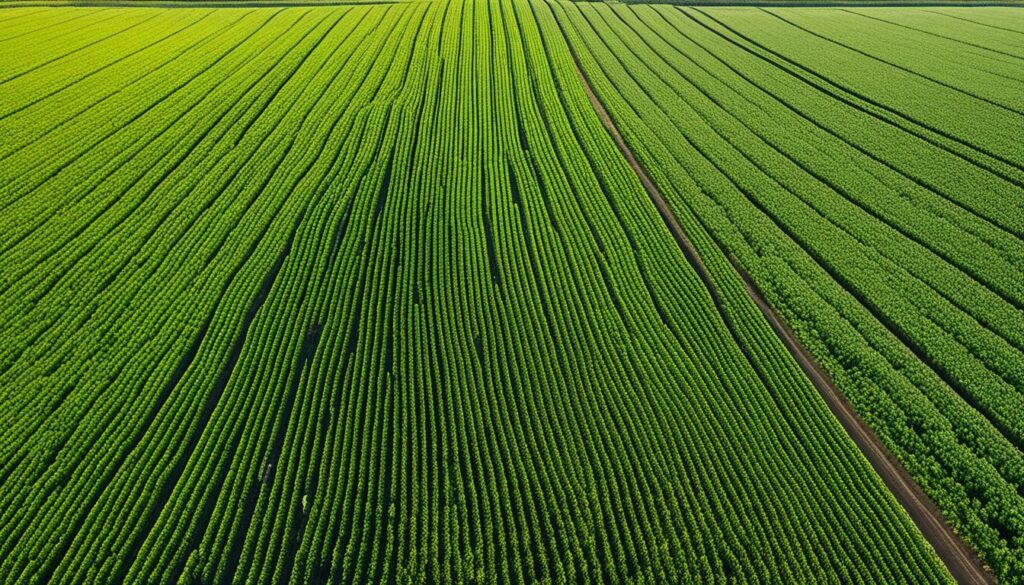
John Deere unveiled the 8R, their first fully autonomous tractor, at the Consumer Electronics Show. This leap points to a future with less need for human work in tough farming jobs. It’s a key step in fighting labour shortages, a problem Canada is facing with an expected 114,000 gap in workers by 2025.
The use of AI in agriculture helps in precise tasks like preparing soil and harvesting. This precision is vital as agriculture uses 70% of the world’s water. It also contributes to 30% of greenhouse gas emissions. Driverless machines help use resources wisely, supporting sustainable farming.
Fendt is developing small, autonomous robots for seed planting. DJI offers flying drones for farming, allowing for better monitoring and targeted pesticide use. These technologies lead to more eco-friendly farming practices.
The field is seeing major growth and innovation. As we blend AI into agriculture, the future looks promising. It will be both efficient and better for the environment, tackling key challenges in production and sustainability.
Autonomous farming tech meets hurdles, matched with solutions. Solving these issues helps tech blend well in farming. The aim is for technology to join hands with modern agricultural methods smoothly.
Tech challenges face autonomous farming’s journey. High initial costs can scare small farms away. Needing technical know-how adds to the issue, especially for those less into tech.Integrating new tech with old ways isn’t easy. The worries about safety and who’s liable also slow things down.
Money matters too. Small farms might not see quick savings from using these techs. This is because a lot of money is needed to get the machines working.
Issues with getting data to rural places make it all harder. The digital gap in the U.S. makes smart farming hard to use in some areas.
The way forward needs many solutions. Teaching tech skills can help bridge the gap.Partnerships can also help, bringing tech and farming worlds closer. Getting help from the government with money or support is another way forward.
Tech needs to fit all kinds of farming to work well. Setting up help like advice hotlines and expert services can also assist.Improving the internet in the countryside also needs a spotlight. This can break down a big tech barrier.
Here’s a closer look at the diverse facets of these challenges and their potential solutions:
| Challenges | Potential Solutions |
|---|---|
| High Initial Costs | Government subsidies, financial incentives |
| Technical Expertise Required | Educational programmes, training initiatives |
| Integration with Existing Processes | Technology tailored to diverse operations, expert support systems |
| Safety and Liability Issues | Stringent regulations, enhanced safety protocols |
| Data Flow and Connectivity Issues | Improved rural cyber infrastructure, robust data solutions |
Tackling smart farming’s issues needs teamwork. You need tech skills, support, and new ideas. Overcoming these challenges will make autonomous farming succeed, changing agriculture’s future.
Autonomous farming robots are key to boosting crop yields and quality. They use precision farming to manage crops with top efficiency. This creates ideal conditions for crops to grow better.
This tech also makes harvest times right, which is vital for quality. Because by 2050, we’ll need to feed 9.7 billion people, we must increase food production by 70%. These robots play a big part in meeting this target.
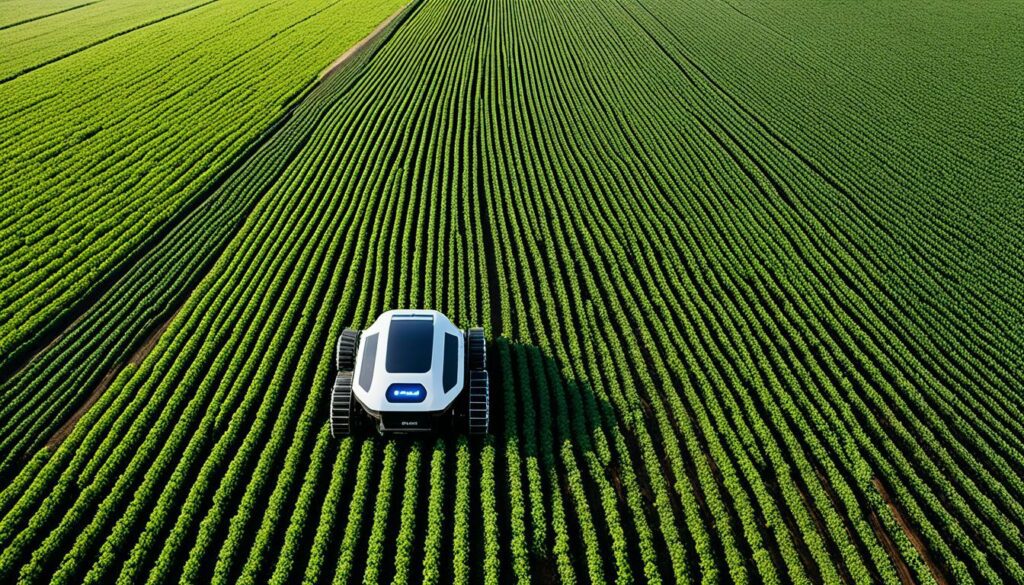
Farm robots help with the lack of farm workers, affecting over 55% of farmers. They not only cut labour costs but also work faster. For instance, a single robot can do the job of 30 workers when picking strawberries.
These machines are also good for the planet. They can cut down pesticide use by 90% by only using them where needed. This is a big step towards a friendlier environment.
With the demand for crops increasing by 60% by 2050, we need to use these technologies. Especially since the market for farming robots is rapidly growing. It went from $43 billion in value in 2021 to a predicted $81 billion by 2028.
These automated systems grow better crops and meet our food needs. Let’s look at how they compare to traditional farming:
| Key Aspect | Traditional Farming | Automated Farming |
|---|---|---|
| Labor Dependency | High (over 50% of cost) | Low (significant cost reduction) |
| Pesticide Usage | High | Up to 90% reduced |
| Crop Yield | Variable | Enhanced |
| Quality of Produce | Inconsistent | Consistent |
So, adopting these farming technologies is critical. They ensure we can keep up with the growing need for food and maintain its quality.
Autonomous farming robots are changing how we do farming for the better. They’re making farming more sustainable and less harmful to the environment. They do this by managing resources better and reducing the impact on nature.
Autonomous robots in farming are making a big difference in using water wisely. They use precision irrigation to water crops exactly when and where it’s needed. For example, Verdant Robotics has smart robots that water crops with extreme accuracy. This prevents water waste and saves this vital resource.
Another big win in farming comes from cutting down on chemicals. Verdant Robotics’ tech can lower pesticide use by a huge 95%. By sprinkling fertilisers and pesticides with great care, crop health and yield improve. And it also helps keep our environment clean.
In 2021, interest in green farming tech really shot up, with more money being invested. Verdant Robotics uses the latest in AI and computer vision to kill weeds better than old methods. This shows why we need to use these nature-friendly tools.
The European Union plans to reduce pesticide use by half by 2023. This is a big move that shows how important it is to farm in a way that’s kinder to our planet. It’s all in line with global goals for a greener world.
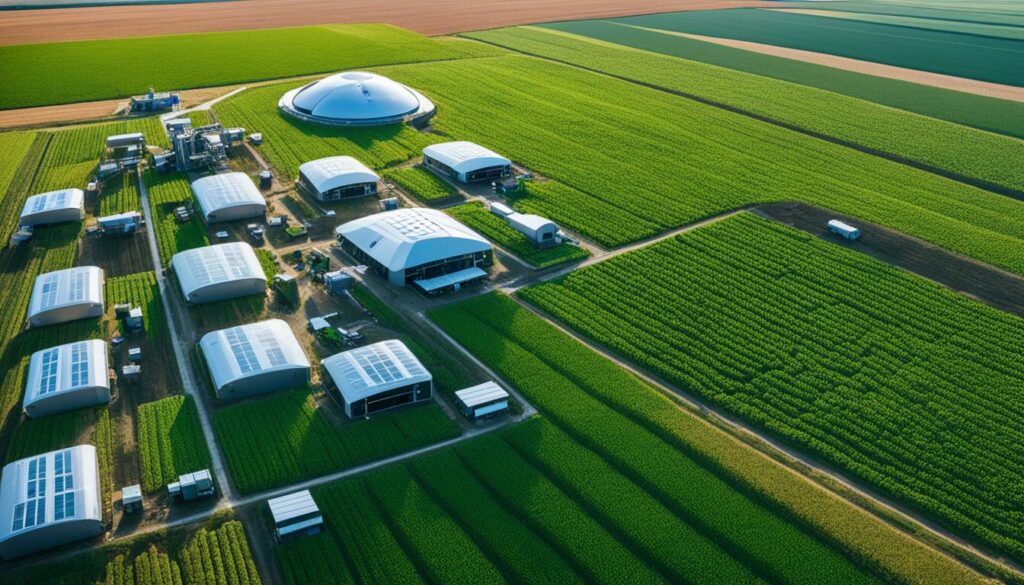
The economy of farming has changed a lot with smart technology. Autonomous farming is making big changes. It reduces the need for manual work, which is costly. This change is key because it helps deal with the lack of labour that many farmers face.
Farm robots, like harvesters, save money by doing the work of many people. They make farming more efficient and cut down on costs. Also, weeding robots can cut down the use of pesticides by a lot, which is good for the environment.
Precision farming is another smart method that helps the planet. It uses less pesticides and fertilisers, saving the earth. It also boosts how much crop we can grow. This is important because we need to grow more food to feed more people in the future.
The tables below show how traditional farming compares to the new autonomous way:
| Aspect | Traditional Farming | Autonomous Farming |
|---|---|---|
| Labour Costs | High | Reduced |
| Chemical Usage | High | Reduced by up to 90% |
| Resource Efficiency | Lower | Higher |
| Environmental Impact | Higher | Lower |
In 2018, farming made up 4% of the world’s economy. Smart farming is changing how we look at its future. By using autonomous systems, farmers can do better and bigger business. The money and advantages from these new technologies are setting up a farming future that’s ready for anything.
The world of farming has been changed by autonomous robots. I’ll highlight two top examples: TerraSentia for crop tracking and Abundant Robotics’ work in apple picking.
TerraSentia by EarthSense is a robot that monitors crops. It gives farmers up-to-the-minute info on their plant health, growth, and how much they produce. Using this info, farmers can make smart choices to improve their crops and make less waste. TerraSentia isn’t just technical; it helps farming be more effective and kind to the Earth.
Abundant Robotics has designed a robot that picks ripe apples. This machine is super smart and quick. It uses special learning programs to spot and pick apples. This way, they boost how quickly they can harvest. And, they don’t rely as much on workers only during certain seasons. It’s a big step forward for making farming more efficient using robots.
Together, TerraSentia and Abundant Robotics are changing how farming is done. These robots use new tech to make farming greener and more productive. They’re leading the way in farming innovation.
Sustainable agricultural practices are making a big impact. Especially, through the use of autonomous farming robots. They help meet several important sustainability goals, such as responsible consumption and production (SDG 12) and fighting climate change (SDG 13).
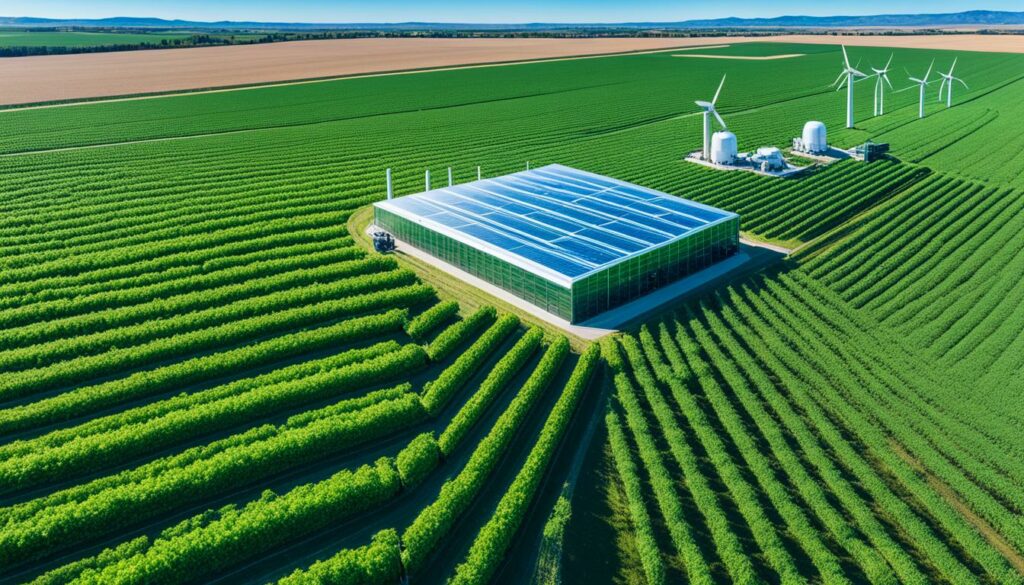
The world will need 60% more crops by 2050, says the FAO. To meet this demand, we need new farming methods. Agricultural robots are key in this. They were worth over $43 billion in 2021. Their value is expected to pass $81 billion by the end of 2028.
Agricultural robots use less water but produce more crops. They’re more sustainable than traditional farming. Also, they play a big part in reducing the use of harmful chemicals.
The European Commission plans to cut chemical pesticide use by 50% in the EU by 2023. Agricultural robots are a big help here. They lower the need for chemicals. This helps cut down on greenhouse gases, which is good for the planet.
These robots also cut down on waste, work more efficiently, and make food easier to trace. This makes farming better for the environment. It also supports the global goals for responsible farming and consumption (SDG 12). Plus, it protects nature by using resources wisely.
Driverless farm machinery marks a big change in farming. It affects labour market effects a lot. Many worry it will take away jobs, but it’s creating new tech-focused roles.
The rise of driverless agricultural technology means less need for manual work. This cuts down on costs for farmers. With machines that can work day and night, farms can produce more using less human work. This change means more employment in smart farming and people doing less hard, more thinking work.
The demand is now for people who can handle and fix these high-tech farm tools. This opens new doors for those good with technology and solving problems. Plus, using these machines can lead to growing better crops and more of them.
So, the farm job scene isn’t shrinking, it’s changing. This change is making the farm world more connected to technology and offering a wider range of jobs. This move could change how farming jobs look, fitting with the trend of more automation and smart farming.
| Key Aspects | Impact |
|---|---|
| Labour Cost Reduction | Eliminates expenses for hiring, training, and wages |
| 24-Hour Operations | Increases yields and operational efficiency |
| Employment Shifts | Creates new roles for tech operation and supervision |
| Crop Quality and Yields | Enhanced through optimal harvesting times |
The world of autonomous farming robots has a bright future. This is thanks to rapid market growth and amazing tech progress. There are many reasons behind the expected rise in the agricultural robots market.
The agricultural robots market is on the rise. Experts think its value could double by 2028. This growth is because more farms are using these high-tech machines. They help farmers work better and more efficiently.
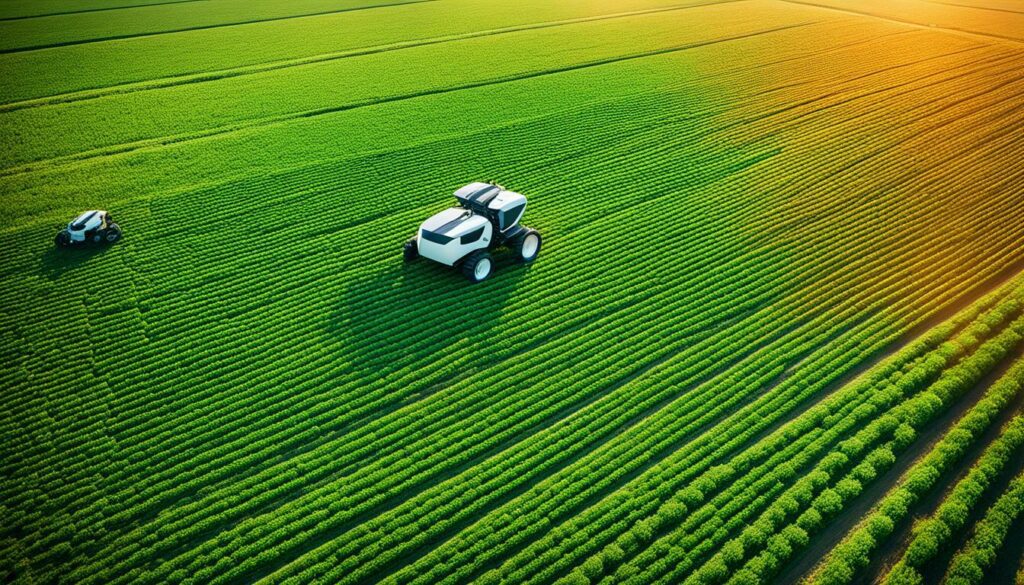
Having more autonomous vehicles on farm work sets up better routines. This boosts how much work gets done. Plus, it means less money spent on hiring people, and farms can run all day and night. This leads to larger harvests and better use of resources.
Tech is driving the future of farming. AI and machine learning make farming robots smarter and more helpful. These robots can now make choices and learn from what they do.
Recently, drones have started helping out in farming, too. They make tasks easier and allow for bigger harvests. Technologies like precision agriculture are also making farming better. They help grow more crops of higher quality.
Autonomous farming also helps protect the planet. It uses fewer harmful chemicals, saves water and soil, and uses more clean energy. These actions make farming kinder to the earth.
Thanks to these advances, farming is becoming more sustainable. Companies like ASI are leading the way with their experience in farming tech for over 13 years. The demand for these machines is growing fast as they get better. This is great news for farming, the environment, and the economy.
Integrating automated agricultural tools makes farming safer and more comfortable. These tools reduce the need for risky manual work. As a result, farmers enjoy better working environments.
Automation in farming uses various tools to make tasks easier and more efficient. For example, machines that work by themselves don’t need breaks. This means they can do more work for longer, reducing the strain on farmers.
This not only makes farming more efficient but also improves how comfortable it is for farmers.
It’s crucial for these machines to meet specific safety standards. These standards ensure tools like autonomous tractors and those using electricity are safe. Cybersecurity standards help keep these systems secure, protecting farmers and workers.
Using automation means fewer farmers are exposed to danger or get hurt from doing the same action over and over. Instead, machines do the hard work, letting farmers focus on managing and making decisions. This makes their job more rewarding and their life better.
Having good network connections is key for machines to work well on their own. But, only half of farms have the right network setup. By using different kinds of networks and technologies like satellites, Wi-Fi, and Bluetooth, more farms can start using these machines.
By considering how automation improves both safety and comfort for farmers, it’s clear these tools are good. They not only make farming better but also take care of the people doing the work.
| Advancements | Importance |
|---|---|
| Reduction in manual labour | Enhances farmer safety and comfort |
| Adherence to safety standards | Ensures safe equipment design |
| Continuous machine operation | Increases productivity while reducing human strain |
| Connectivity options | Promotes streamlined and efficient operations |
Reflecting on the use of autonomous robots in farming, it’s clear they’re changing the game. They are key in meeting the increasing demand for food worldwide. This demand is expected to rise by 60% by 2050, according to the United Nations.
These robots are making a big economic impact, too. Their market has grown to be worth over $43 billion in 2021. By 2028, it’s predicted to exceed $81 billion. Their ability to save water and produce more food efficiently is changing farming for the better.
Autonomous technology is also easing labour issues in farming. They cut down on work needed and help where there’s a lack of hands. This is crucial as over half of farmers face this issue. These robots help us keep up with crop demands by working smarter, not harder.
They also help the planet by using less harmful chemicals and saving water and soil. These aspects are vital for a greener future. As demands grow for eco-friendly farming, these robots stand out. They are a big part of reaching sustainable agriculture goals.
In conclusion, robots are shaping the future of farming. They blend new tech with old farming wisdom to meet global food needs. They offer a sustainable path forward for farming, benefiting future generations.
These robots use AI to handle farm jobs. They plant, water, fight pests, and gather crops. Their goal is to work more efficiently, save money on workers, and grow more food.
They help farms use resources better. They cut down on waste and lessen harm to the environment. This meets goals for responsible farming and fighting hunger.
Robotic farming increases how much we get done, cuts down on work costs, and improves the harvest. Using AI means we do farming tasks more accurately and with less waste.
Important technologies are precision farming and drones. Also, AI and learning machines, and self-driving farm tools. These tools watch closely, act where needed, and keep working without a break, helping farms a lot.
For example, TerraSentia checks on plants to give farmers important health data. Abundant Robotics makes robots that pick apples faster and more accurately.
They make growing conditions perfect and get crops out at just the right time. This makes the harvest bigger and food better. They also fill in when there aren’t enough workers and speed things up.
The problems are the high price to start, needing to be tech-savvy, and fitting new robots into old ways of farming. Solving these needs learning, teaming up with tech firms, and help with the bills.
They save water using carefully aimed irrigation and use less chemicals for bugs and feeding. This keeps the environment healthier and farms following good environmental rules.
Farming smarter spends less on work and uses resources better. This makes farming make more money and able to grow. It changes how farming makes money.
Driverless machines might put some out of work, but they also need people to set them up, watch over them, and fix them. This makes farming less hard work and more thinking work for people.
By 2028, the farming robot business is set to really take off. Thanks to AI, learning machines, and teams of robots working together, farming will be more productive, green and a good business.
These robots do the hard and dangerous work so farmers don’t have to. This makes farming safer, happier and better for the people who do it.